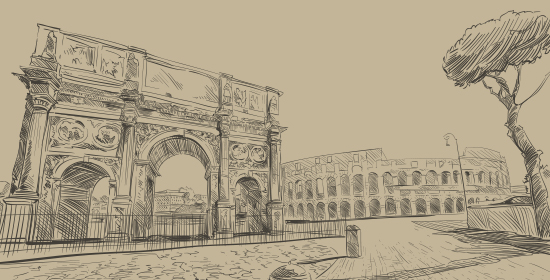Discover the 7 Wonders of Hadrian’s Villa in Tivoli
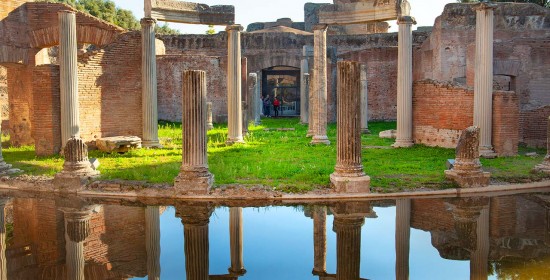
Buongiorno and welcome to RomeCabs, Rome’s top-rated tour company for Day Tours from Rome and Private Excursions from Civitavecchia. Step into the world of ancient Rome and discover the 7 Wonders of Hadrian’s Villa in Tivoli, where breathtaking splendor and architectural marvels await at every turn.
This remarkable estate commissioned by Emperor Hadrian stands as one of Italy’s most magnificent historical sites. Situated in the picturesque landscape of Tivoli, just outside of Rome, this UNESCO World Heritage site invites visitors to explore the architectural wonders and lavish designs that once epitomized the grandeur of imperial life.
This vast imperial estate in Tivoli became his retreat from Rome where he sought refuge from the chaos of the city, At times, Hadrian’s Villa even served as his seat of power where he ruled the Roman Empire amidst serene gardens, opulent baths, and stunning halls surrounded by nature and fresh air.
Originally comprising over 30 monumental and scenic buildings, including temples, libraries, and palatial quarters, Hadrian’s Villa was a true city within a city, reflecting his far-reaching vision and appreciation for diverse cultures. From intricately designed bathhouses and serene pools to stunning colonnades and gardens, Hadrian’s Villa offers a unique glimpse into the life and vision of one of Rome’s most culturally influential emperors.
In this blog, we will share with you the 7 wonders of Hadrian’s Villa that can’t be missed. Each site showcases the exceptional skill of ancient Roman architects and offers an unforgettable journey through time.
The 7 Wonders of Hadrian’s Villa in Tivoli
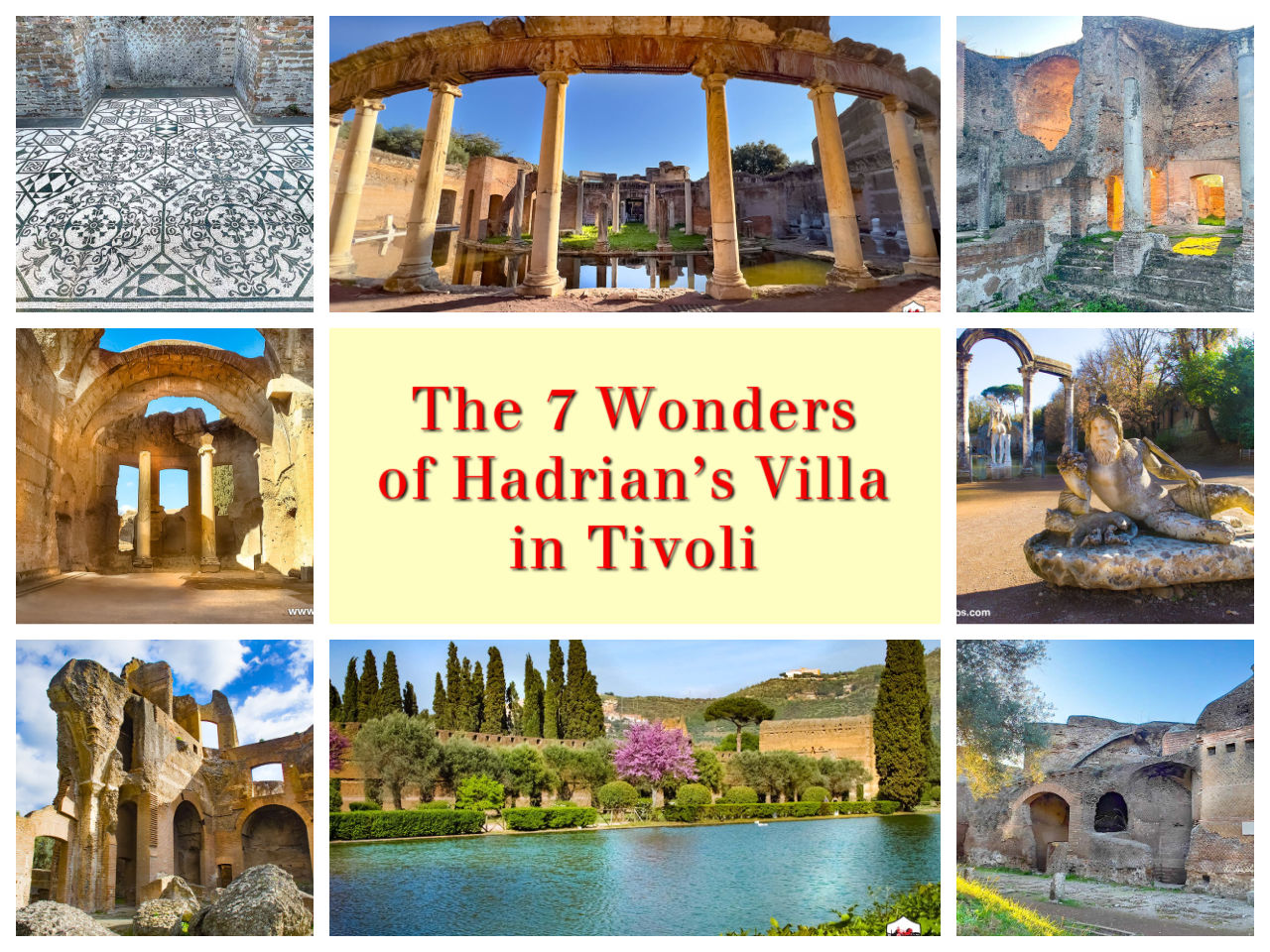
1. The Canopus and Serapeum: A Taste of Egyptian Splendor
First on our list of the 7 Wonders of Hadrian’s Villa in Tivoliis the Canopus and Serapeum. One of the most visually captivating features of Hadrian’s Villa, the Canopus, and Serapeum complex, stands as a tribute to Hadrian’s admiration for Egypt and his desire to incorporate diverse architectural elements into his imperial retreat.
This grand pool complex takes its name and inspiration from the Canopus Canal near Alexandria and mimics the ambiance of an Egyptian oasis. It’s an extraordinary example of how Hadrian’s Villa blended different cultural influences, creating spaces that were both architecturally impressive and symbolically rich.
The Canopus stretches along a long, narrow basin framed by statues, columns, and caryatids, offering a luxurious and exotic setting. Statues along the pool include depictions of Greek and Egyptian deities, blending mythological motifs from different cultures and enhancing the mystical aura of the space. These statues include representations of river gods, Amazons, and even crocodiles, creating an immersive scene reminiscent of the Nile’s banks and underscoring Hadrian’s fascination with distant lands.

At the end of the Canopus is the Serapeum, a semi-circular structure with a partial dome, which served as a shaded dining and lounging area for the emperor and his guests. Believed to honor Serapis, an Egyptian deity who symbolized healing and the afterlife, the Serapeum brought both religious symbolism and architectural innovation into play.
The dome’s curvature and construction were marvels of Roman engineering, providing much-needed shade and creating a cool, comfortable space for social gatherings.

The Canopus and Serapeum’s Architectural Significance
The Serapeum’s partial dome is an early example of Roman experimentation with curved structures that would later influence designs like the Pantheon’s dome. The semi-dome, supported by intricate columns, allowed Hadrian’s guests to enjoy the tranquil atmosphere of the Canopus without direct exposure to the sun—a testament to the villa’s thoughtful approach to comfort.
Water features and shaded areas were central to Hadrian’s Villa, reflecting the luxurious lifestyle he intended for his imperial sanctuary.

Symbolism and Cultural Synthesis of Canopus and Serapeum
The Canopus and Serapeum represent Hadrian’s interest in cultural fusion. His travels through the Roman Empire had exposed him to Greek, Egyptian, and Near Eastern influences, which he embraced and integrated into the villa’s design. The statues and carvings around the Canopus depict mythological scenes and figures from both Greek and Egyptian traditions, creating a place where cultures merge visually and symbolically.
Today, walking along the Canopus transports visitors back to a world of imperial luxury and cultural synthesis. The shimmering water, framed by remaining marble statues and lush greenery, remains one of the most photogenic spots in Hadrian’s Villa, making it a favorite among photographers and history enthusiasts.
It’s easy to imagine Hadrian and his guests relaxing here, surrounded by art and architecture that celebrated the diversity and grandeur of the empire. This section of the villa is not just a pool or garden—it’s a meticulously crafted experience, where beauty, culture, and comfort come together, capturing the spirit of Hadrian’s eclectic and visionary empire.

2. The Maritime Theater: Hadrian’s Private “Island”
At the heart of Hadrian’s Villa lies the Teatro Marittimo, or Maritime Theater, a masterpiece of architectural innovation and symbolic design. This circular island retreat, encircled by a moat, served as Hadrian’s private sanctuary—a place where the emperor could escape the demands of political life and immerse himself in solitude and contemplation. Accessible only by a narrow drawbridge, this secluded island represents Hadrian’s desire for privacy and his preference for spaces that have allowed him both reflection and respite.
The Maritime Theater consists of a circular island surrounded by a wide, water-filled moat, with an Ionic colonnade encircling the outer edge. The colonnade’s graceful columns lend the space a serene, balanced quality, while the overall circular design is a striking departure from traditional Roman architecture.
Most Roman buildings favored rectangular or square layouts, but the Maritime Theater’s round form reveals Hadrian’s fascination with Greek and Hellenistic influences. It’s also thought to reflect Hadrian’s philosophical inclinations and his appreciation for geometry, symmetry, and harmony in architectural design.
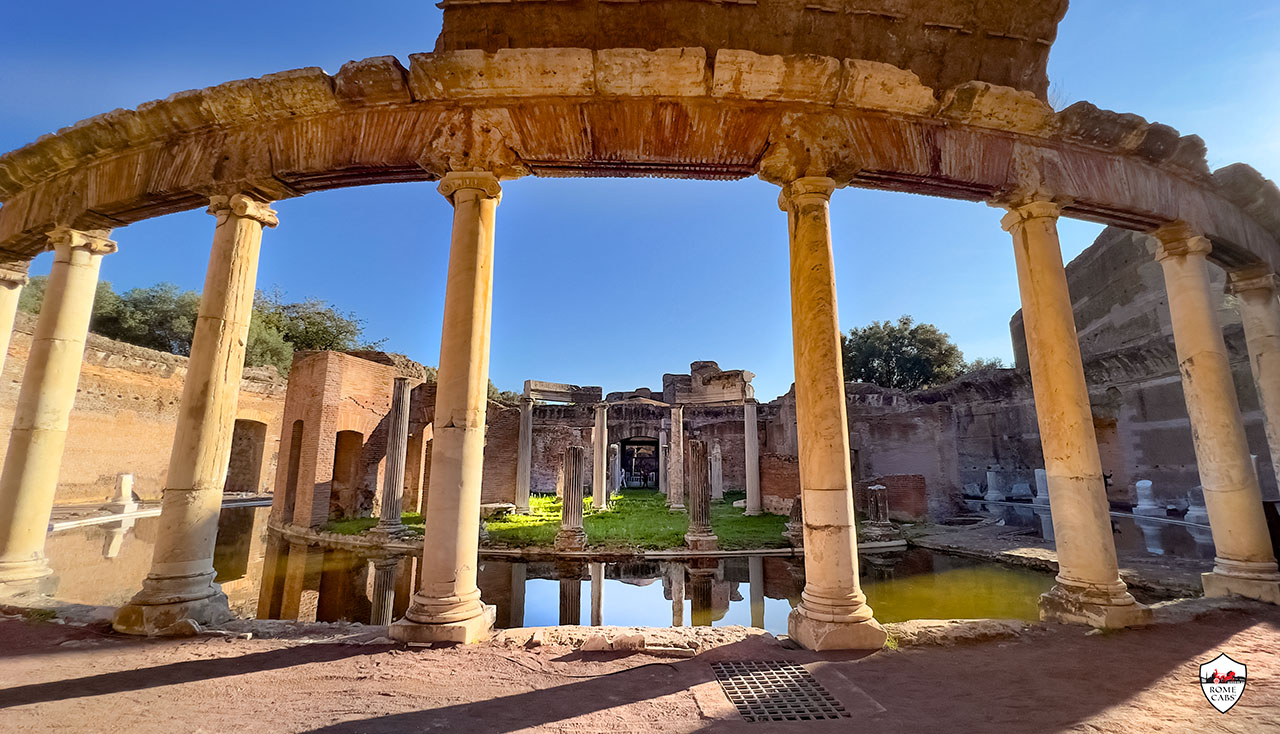
A Sanctuary of Intellectual and Personal Retreat
Within the island itself is a carefully arranged series of rooms, including a private bath, library, sleeping quarters, and living spaces, creating a self-contained residence that fulfilled all the emperor’s personal needs. This setup allowed Hadrian to enjoy time alone in a meditative atmosphere, where he could read, write, and contemplate ideas without interruption.
The inclusion of a library further underscores the emperor’s love for literature and philosophy, providing a space where he could engage in intellectual pursuits. For an emperor renowned for his wide-ranging interests, the Maritime Theater offered a rare retreat for creative and strategic thinking.
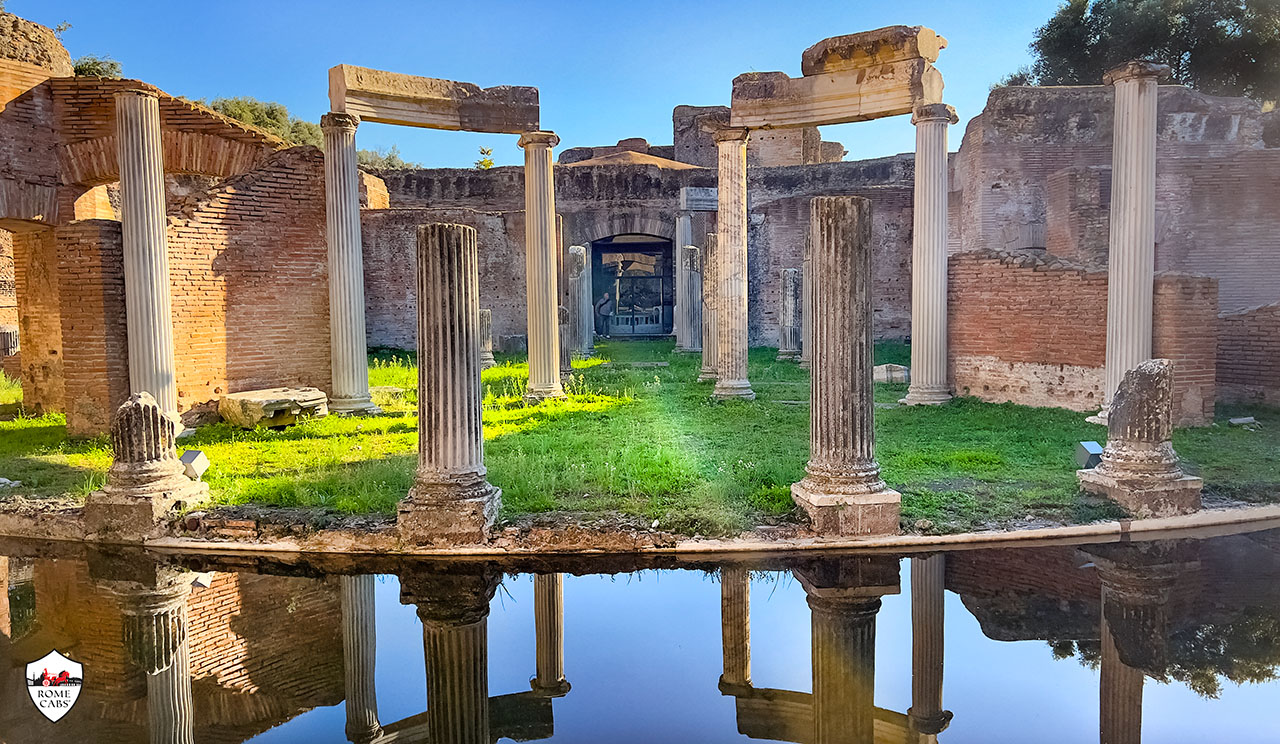
Symbolic and Architectural Marvel
The Maritime Theater is unique not only for its circular form but also for its clever use of architectural symbolism. The circular shape, reflecting the cyclical nature of time and harmony, was likely chosen to create a feeling of unity and perfection.
This layout, combined with the surrounding water, also echoes the tradition of Greek nymphaeums (sacred spaces dedicated to nymphs), imbuing the space with a sense of tranquility and mysticism. Some historians believe the water may have also helped cool the air around the structure, making the island even more comfortable during warm weather.
The moat itself adds to the sense of isolation, functioning almost like a natural barrier that separated Hadrian’s personal space from the rest of the villa. The island's limited access via drawbridge ensured that only a few, if any, trusted individuals could reach him. This privacy made the Maritime Theater a symbolic retreat within Hadrian’s Villa—a microcosm of the emperor’s life philosophy, combining natural elements, introspective solitude, and the pursuit of knowledge.
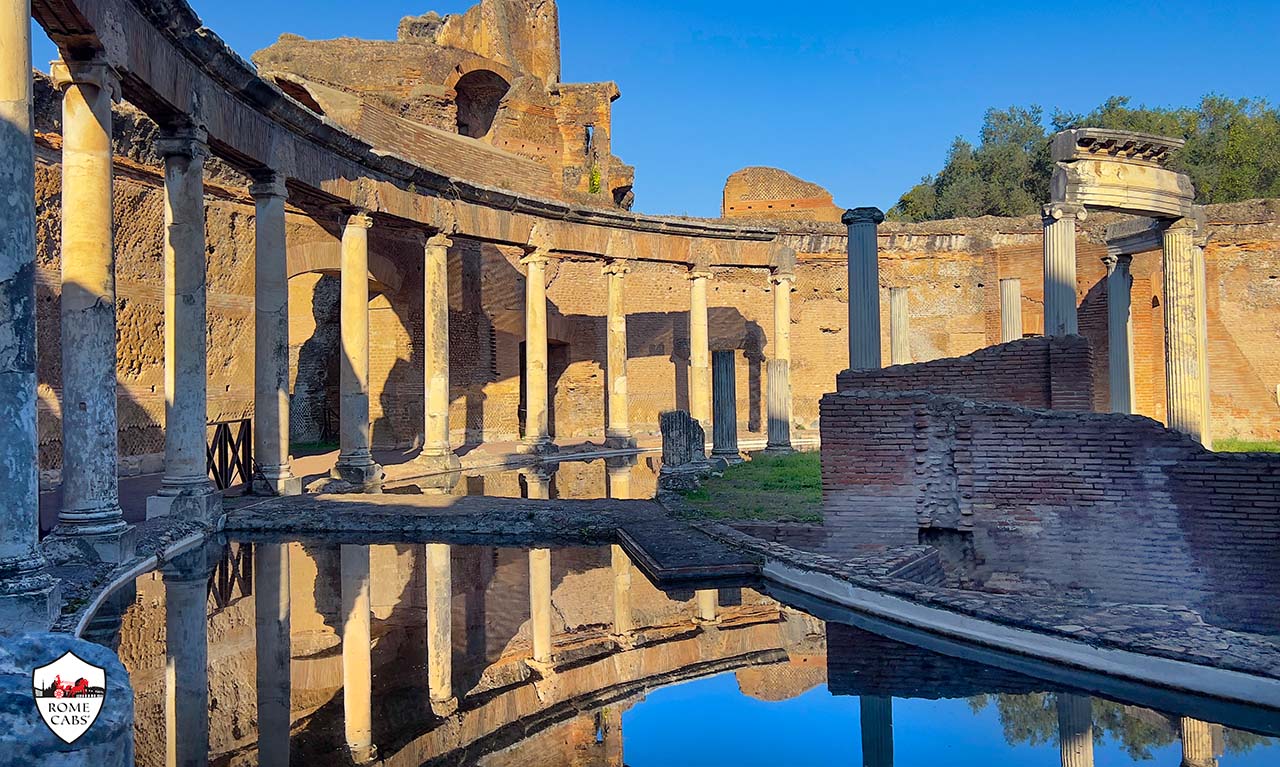
A Blend of Beauty, Tranquility, and Practicality
Apart from its symbolic and intellectual significance, the Maritime Theater reflects Roman engineering prowess and attention to detail. The construction required advanced hydraulic technology to manage the water levels and prevent overflow. The colonnade and surrounding spaces would likely have been decorated with frescoes, statues, and perhaps mosaics, enhancing the theater’s visual appeal.
Today, the Maritime Theater remains one of the most captivating and mysterious sites within Hadrian’s Villa, inviting visitors to imagine the quiet moments the emperor may have spent here, away from the public eye. It captures Hadrian’s desire for balance between power and introspection, beauty and simplicity. This secluded island within Hadrian’s Villa offers a window into the emperor’s private world, showcasing a visionary space where he could reflect, dream, and find sanctuary amidst his grand estate.

3. The Pecile: A Place of Reflection and Beauty
Next on our list of 7 Wonders of Hadrian’s Villa in Tivoli is the Pecile - located just when you enter the Imperial complex. Inspired by the renowned Stoa Poikile in Athens, the Pecile at Hadrian’s Villa is a vast rectangular courtyard that stands as a tribute to the emperor’s admiration for Greek culture and philosophy.
Unlike the more structured and formal layouts of traditional Roman gardens, the Pecile emphasizes open space and natural flow, creating an atmosphere that invites quiet reflection, physical exercise, and communion with nature. Enclosed by a stately colonnade, the courtyard’s design fosters a sense of tranquility, allowing Hadrian and his guests to experience moments of stillness amid the beauty of the villa.
The central pool is a defining feature of the Pecile, with its calm waters capturing reflections of the sky, colonnades, and surrounding trees. This reflective quality gives the area an almost mystical ambiance, adding to the sense of serenity.

The pool’s layout may have been inspired by Greek practices, which often incorporated water elements as focal points within open spaces. Hadrian’s thoughtful incorporation of these elements reflects his desire to create a space where mind and body could find balance—a concept deeply rooted in Greek philosophical traditions.
Pecile's Greek Influence and Architectural Harmony
The Pecile’s design is a clear homage to Greek architecture and philosophical ideals. In ancient Athens, the original Stoa Poikile was not just an architectural landmark but also a center for philosophical discourse, particularly for the Stoics, who valued tranquility and virtue.
By recreating this Athenian landmark in his villa, Hadrian may have aimed to introduce these same virtues into his imperial retreat. The openness of the Pecile represents the Greek appreciation for the interplay between natural beauty and architectural form, a balance that was considered essential for intellectual and physical well-being.

The Pecile was a Space for Contemplation and Exercise
The Pecile was not only a place for quiet contemplation but also a space where visitors could engage in light physical activity, such as walking or even practicing meditative exercises. The shaded colonnade surrounding the courtyard provided a cool, sheltered path ideal for leisurely strolls. This would have been particularly enjoyable during the summer months, offering relief from the Italian heat. Here, Hadrian could blend the physical benefits of exercise with the mental calm of a natural setting, creating a space that truly embodied his holistic approach to health and wellness.
The Pecile’s significance goes beyond its architectural grandeur; it underscores Hadrian’s reverence for Greek philosophy and design principles. Ancient Roman gardens were typically characterized by symmetry and precise form, often serving as controlled, ornamental spaces. In contrast, the Pecile embraces the Greek ideal of openness and natural flow, where mind and body could coexist in a state of balance.
This deviation from Roman tradition illustrates Hadrian’s appreciation for Greek culture, and his desire to incorporate those values into his personal retreat, making the Pecile one of the villa’s most unique and meaningful spaces.

4. The Great and Small Baths: Relaxation and Engineering
Considered wonders of Hadrian’s Villa are the Great and Small baths. In ancient Roman society, baths were far more than places for personal hygiene; they served as essential social hubs and leisure spaces where people gathered, relaxed, and connected.
At Hadrian’s Villa, the Great Baths and Small Baths epitomize this tradition, embodying luxury, comfort, and the emperor’s commitment to architectural excellence. Each bath complex at Hadrian’s Villa was carefully designed to offer a serene retreat for socialization, exercise, and rejuvenation—reflecting the integral role baths played in Roman daily life.
The Great Baths, a grander and more expansive complex, served as the primary bathing area for the villa’s guests, accommodating larger groups who came to Hadrian’s estate. This impressive space featured spacious pools, vaulted ceilings, and elaborately decorated rooms, making it ideal for socializing and relaxation.

Guests could enjoy a range of bathing experiences here, moving through the frigidarium (cold room), tepidarium (warm room), and caldarium (hot room), following the Roman tradition of progressing through various temperature zones to maximize health benefits and relaxation.
The Small Baths, on the other hand, were a more intimate space reserved exclusively for Hadrian and his close associates. While smaller in scale, this complex maintained the same luxurious standards, with intricate mosaics and advanced heating systems.
The Small Baths offered Hadrian a private retreat within the villa, where he could enjoy solitude or intimate gatherings, away from the more public atmosphere of the Great Baths. This dual bath setup allowed Hadrian’s Villa to cater to both the emperor’s personal needs and the social demands of hosting guests, illustrating a thoughtful balance between public hospitality and private luxury.

The Ingenious Hypocaust Heating System
One of the most impressive aspects of the Great and Small Baths is their hypocaust system, a sophisticated Roman method for heating floors and walls that created a warm, inviting environment throughout the year. In the hypocaust system, furnaces would channel hot air beneath the floors and behind the walls, efficiently heating the rooms.

This allowed for temperature-controlled spaces even in winter, a luxury that few could afford at the time. The hypocaust technology demonstrated the advanced engineering prowess of Roman architects and engineers, who mastered climate control in a way that allowed for comfortable bathing regardless of the season.
The hypocaust system required careful planning for fuel and ventilation. Enslaved workers were tasked with keeping the furnaces stoked, adjusting vents to allow for warm air circulation without excessive smoke or fumes, and maintaining a steady temperature across different rooms. Their constant, skilled attention to the hypocaust’s operation highlights the complexity of Roman luxury estates and the significant effort required to uphold Hadrian’s vision of comfort.

5. The Thermae with Heliocaminus: A Sunlit Innovation
Among the architectural wonders of Hadrian’s Villa, the Thermae with Heliocaminus stands out for its ingenious design, achieved through the vision of skilled architects under the patronage of Emperor Hadrian.
Named after the heliocaminus, or "sunroom", this bath complex epitomizes the forward-thinking approach that Hadrian encouraged in his architectural projects. Designed to harness natural sunlight for warmth, the Heliocaminus was an innovative feature for its time, reducing the need for traditional fuel-based heating—a rare accomplishment in ancient Roman bathhouses.
Unlike the more common rectangular layouts of Roman baths, the Heliocaminus bath is distinctive for its circular structure. This unusual shape not only optimized sunlight intake but also enhanced the acoustic and visual experience for those inside, creating a welcoming, sunlit atmosphere that was ideal for relaxation, especially in colder months. By allowing sunlight to stream into this circular space, the architects achieved a naturally heated environment that demonstrated remarkable ingenuity.

Thermae with Heliocaminus Blended Functionality and Luxury
The architects who designed the Heliocaminus bath complex also equipped it with a dual heating system. While sunlight provided natural warmth on bright days, an advanced hypocaust system—an underfloor heating method—ensured comfort even on cloudy days. This combination of natural and engineered heating reflects a level of sophistication that is impressive even by modern standards, allowing the Heliocaminus to maintain a comfortable temperature year-round.
The interior décor of the Heliocaminus further reflects the luxurious touch encouraged by Hadrian. The walls and floors were likely adorned with rich marble and detailed mosaics, creating a visually stunning setting that matched the room’s practical innovations.

Frescoes and finely crafted stonework likely embellished the walls, surrounding the visitors in an atmosphere of elegance. This attention to both beauty and function made the Heliocaminus more than just a bath; it was a statement of the refined aesthetic fostered by Hadrian’s patronage.
Today, the Heliocaminus remains a testament to the innovative spirit that flourished under Hadrian’s reign.
6. Greek and Latin Libraries: Centers of Knowledge
Hadrian’s Villa was more than a luxurious retreat; it was also a center of intellectual and cultural pursuits that reflected the emperor’s deep passion for learning and scholarship. Among its many architectural marvels, the villa included two separate libraries—the Greek Library and the Latin Library—each dedicated to texts in their respective languages.
This distinction underscores Hadrian’s reverence for both Greek and Roman literary traditions, as well as his vision of creating a space where leisure and learning coexisted. These libraries likely housed an impressive collection of scrolls, manuscripts, and philosophical works from some of the most influential thinkers of antiquity.
Although less intact than other areas of the villa, the remains of the Greek and Latin Libraries stand as powerful symbols of Hadrian’s intellectual ambitions. Even in ruins, they serve as a testament to his desire to cultivate knowledge and foster a space for cultural enrichment.
In ancient times, these libraries would have allowed Hadrian and his esteemed guests to delve into the worlds of literature, philosophy, and science, making the villa not only a residence but also a sanctuary for the mind.

The Greek Library: A Gateway to the Hellenistic World
The Greek Library at Hadrian’s Villa was dedicated to texts written in Greek, a language that Hadrian greatly admired and spoke fluently. His fascination with Greek culture was profound, extending to its philosophy, literature, and art, all of which heavily influenced his reign.
In this library, one could imagine collections of works by Greek philosophers such as Plato, Aristotle, and Epicurus, along with dramatic works by Sophocles, Euripides, and Aristophanes. Additionally, historical accounts by Herodotus and Thucydides and scientific treatises by Hippocrates and Archimedes may have lined the shelves.
The Greek Library would have offered Hadrian and his guests a way to connect with Greek ideals, fostering philosophical discussions and reflections on Hellenistic thought. The emperor’s passion for Greek culture wasn’t just academic; he saw Greek philosophy as integral to a refined and balanced life, which is reflected in the design and purpose of this library. The library would have been a serene setting and may have also possibly been adorned with Greek-style frescoes and statues, creating an atmosphere of quiet contemplation.

The Latin Library: Celebrating Roman Heritage and Wisdom
The Latin Library represented the intellectual heritage of Rome, celebrating the works of renowned Roman authors and scholars. This library likely housed volumes of Cicero, Virgil, Seneca, Livy, and Ovid, as well as practical treatises on subjects such as engineering, architecture, and governance—topics that would have aligned well with Hadrian’s own interests. The Latin Library offered a space where Hadrian could explore Rome’s intellectual legacy, drawing from the wisdom of its statesmen, poets, and thinkers.
While the Greek Library symbolized Hadrian’s admiration for foreign cultures, the Latin Library underscored his commitment to Rome’s traditions. In this library, guests might have found texts on Roman law, politics, and history, serving as a reminder of the empire’s identity and resilience.
Together, the Greek and Latin Libraries illustrate Hadrian’s vision of a retreat that celebrated both leisure and intellectual engagement. In today’s ruins, the Greek and Latin Libraries remain symbols of Hadrian’s passion for knowledge and learning. They demonstrate his sophisticated approach to leadership, where wisdom from diverse cultures could coexist and inform a more enlightened imperial worldview.

7. The Hospitalia: Lavish Guest Quarters
Last on our list of 7 Wonders of Hadrian’s Villa in Tivoli is famous for its beautiful floor mosaics that can’t be missed. The Hospitalia, or guest quarters, at Hadrian’s Villa stand as one of the estate’s most beautifully designed spaces, crafted to accommodate the dignitaries, officials, and esteemed guests who visited the emperor. These quarters exemplify Roman luxury and hospitality, providing not only comfort but also an experience of the grandeur that Hadrian wished to extend to his visitors.
With checkerboard-patterned mosaic floors, vaulted ceilings, and refined architectural details, the Hospitalia allowed Hadrian’s guests to enjoy a level of comfort and elegance that mirrored the villa’s overarching magnificence.

A Must-See: Exquisite Floor Mosaics of the Hospitalia
One of the must-see sites in Hadrian’s Villa is the Hospitalia’s exquisite floor mosaics, which remain some of the most visually captivating details within Hadrian’s Villa. The checkerboard patterns of black and white marble tiles create a sophisticated yet playful contrast, adding depth and visual intrigue to the rooms.
These mosaics aren’t merely decorative—they reflect the Roman skill in using geometric patterns to enhance space and light within a room. For visitors, the mosaics are a must-see feature, providing insight into the artistic techniques and aesthetic values of the time. Each step along these intricately laid tiles brings you closer to the lavish world that Hadrian crafted for his guests.

The Hospitalia's Architectural Grandeur
The vaulted ceilings in the Hospitalia not only add to the rooms’ aesthetic appeal but also serve a practical function, helping to regulate airflow and maintain a cooler environment during warm months. The combination of high ceilings and open spaces gave the guest quarters a sense of spaciousness, which would have been particularly appealing for guests accustomed to the bustling, crowded urban centers of the empire.
Decorative touches likely included wall frescoes and perhaps sculptural elements, making the Hospitalia not only a functional space for rest but also an immersive experience in Roman luxury. The elegant design and comfort of the Hospitalia highlight the villa’s role as a social hub, where Hadrian welcomed visitors from across the empire, extending the warm embrace of Roman hospitality.
Explore Hadrian’s Villa with RomeCabs:
Tivoli Villas Tour from Rome &
Tivoli Post-Cruise Tours from Civitavecchia
For travelers eager to explore Italy’s treasures beyond Rome, RomeCabs offers the perfect solution. Our thoughtfully crafted Day Tours from Rome to Tivoli and Post Cruise Tours from Civitavecchia provide a comfortable, convenient, and immersive way to discover Tivoli’s rich heritage.
Experience the elegance of Villa d’Este, the ancient majesty of Hadrian’s Villa, and the allure of Tivoli’s historic charm—all with the quality service and convenience RomeCabs is known for.
RomeCabs Day Tours from Rome to Tivoli
Our Day Tours from Rome whisk you away from the lively streets of the city to Tivoli, a picturesque town steeped in Renaissance and ancient Roman history. Relax in a deluxe, air-conditioned vehicle as our experienced English-speaking driver guides you on a scenic journey to Tivoli.
This tour allows you to experience Tivoli’s two UNESCO World Heritage Sites: the enchanting Villa d’Este, with its spectacular fountains and beautifully manicured gardens, and the historic Hadrian’s Villa, once the grand retreat of Emperor Hadrian.
Immerse yourself in the ruins of Hadrian’s Villa, where remnants of grand halls, thermal baths, and serene pools reveal the luxury of ancient Rome. Then, wander through Villa d’Este’s intricately designed gardens and marvel at the artistry of Renaissance waterworks.
With RomeCabs, you’ll have ample time to explore each location at your own pace, fully soaking in the unique history and beauty of Tivoli.
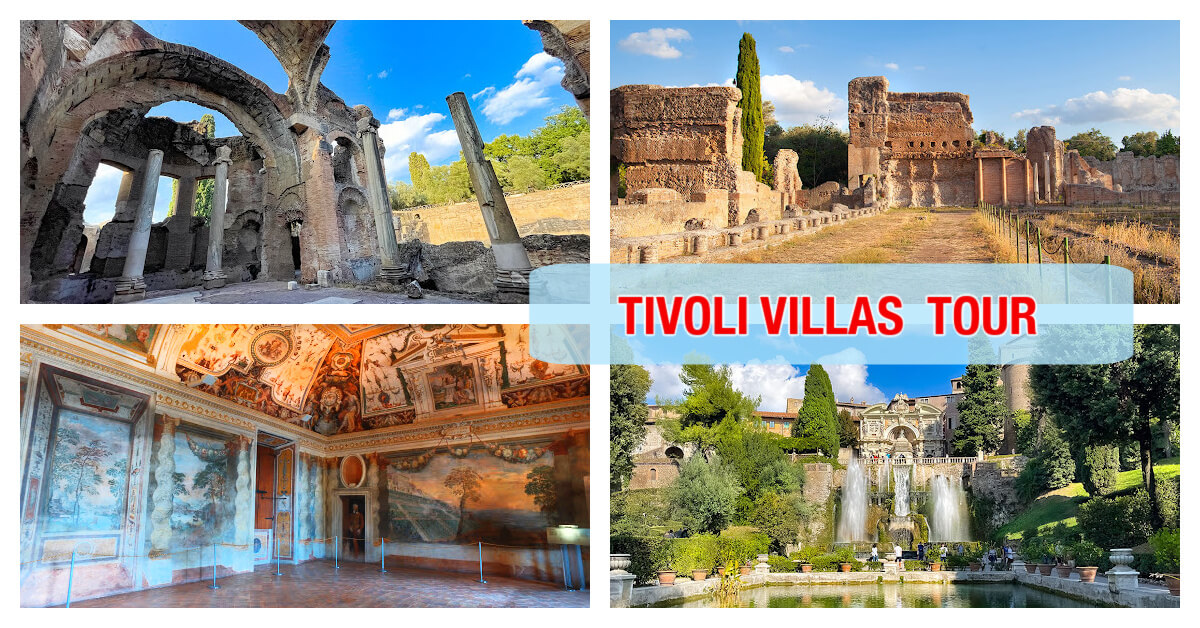
Post Cruise Tours from Civitavecchia to Tivoli
For cruisers finishing a Mediterranean cruise in Civitavecchia, our Post Cruise Tours from Civitavecchia provide a unique way to spend your disembarkation day. Instead of going straight to your hotel, you can extend the excitement of your cruise with an enriching post-cruise tour to Tivoli’s Villas. We’ll pick you up directly from the port, making it easy to reach Villa d’Este and Hadrian’s Villa without the hassle of coordinating multiple transfers.
Travel in comfort as our knowledgeable driver transports you to Tivoli’s Villas, where you’ll have time to explore the breathtaking landscapes and historic architecture. There’s no need to worry about your luggage; it will be securely stowed in the vehicle’s luggage compartment while you enjoy your tour.
When your visit concludes, you’ll be conveniently taken to your hotel in Rome, ensuring a smooth and enjoyable experience from start to finish.
Book Your Tivoli Tour with RomeCabs Today
Book your Tivoli Day Tour from Rome or Post Cruise Tour from Civitavecchia and enjoy a day filled with beauty, history, and relaxation in one of Italy’s most captivating destinations.
Thank you for reading our travel blog 7 Wonders of Hadrian’s Villa in Tivoli and for choosing RomeCabs for your day tours from Rome and private excursions from Civitavecchia. We look forward to showing you beautiful places in Italy!
DISCOVER MORE OF ITALY with RomeCabs Travel Blogs:
- Silent Sentinels: The Timeless Guardians of Tuscania's Landscape near Rome
- Ceri: Must-See Charming Italian Medieval Hamlet Frozen in Time
- Tips on How to Visit Bracciano Castle (Castello Orsini - Odescalchi)
- The Best Day Tours from Rome you can’t miss this summer
- Monterozzi Necropolis: Exploring Etruscan Painted Tombs in Tarquinia
* Find RomeCabs online also on:
- RomeCabs FACEBOOK
- RomeCabs PINTEREST
- RomeCabs TWITTER
- RomeCabs INSTAGRAM
- RomeCabs FLICKR Photo Gallery
- RomeCabs Recommended on Cruise Critic
- More RomeCabs blogs: https://rome-cabs.net/
